In-depth Analysis: Determinants of Health, Inequity, and Interventions
VerifiedAdded on 2023/06/14
|12
|3138
|192
Report
AI Summary
This report provides a comprehensive analysis of the determinants of health, categorizing them into biological, social, and environmental factors. It discusses how these determinants, such as age, income level, and air pollution, impact health differently across various groups, leading to health inequities and inequalities. The report also explores public health interventions aimed at improving health and well-being, including vaccinations, safety measures, and healthy food initiatives. Furthermore, it touches upon theories of health and health promotion, emphasizing the importance of addressing social determinants to reduce health disparities and improve overall community and individual health outcomes. The document is a student contribution and more solved assignments are available on Desklib for students.
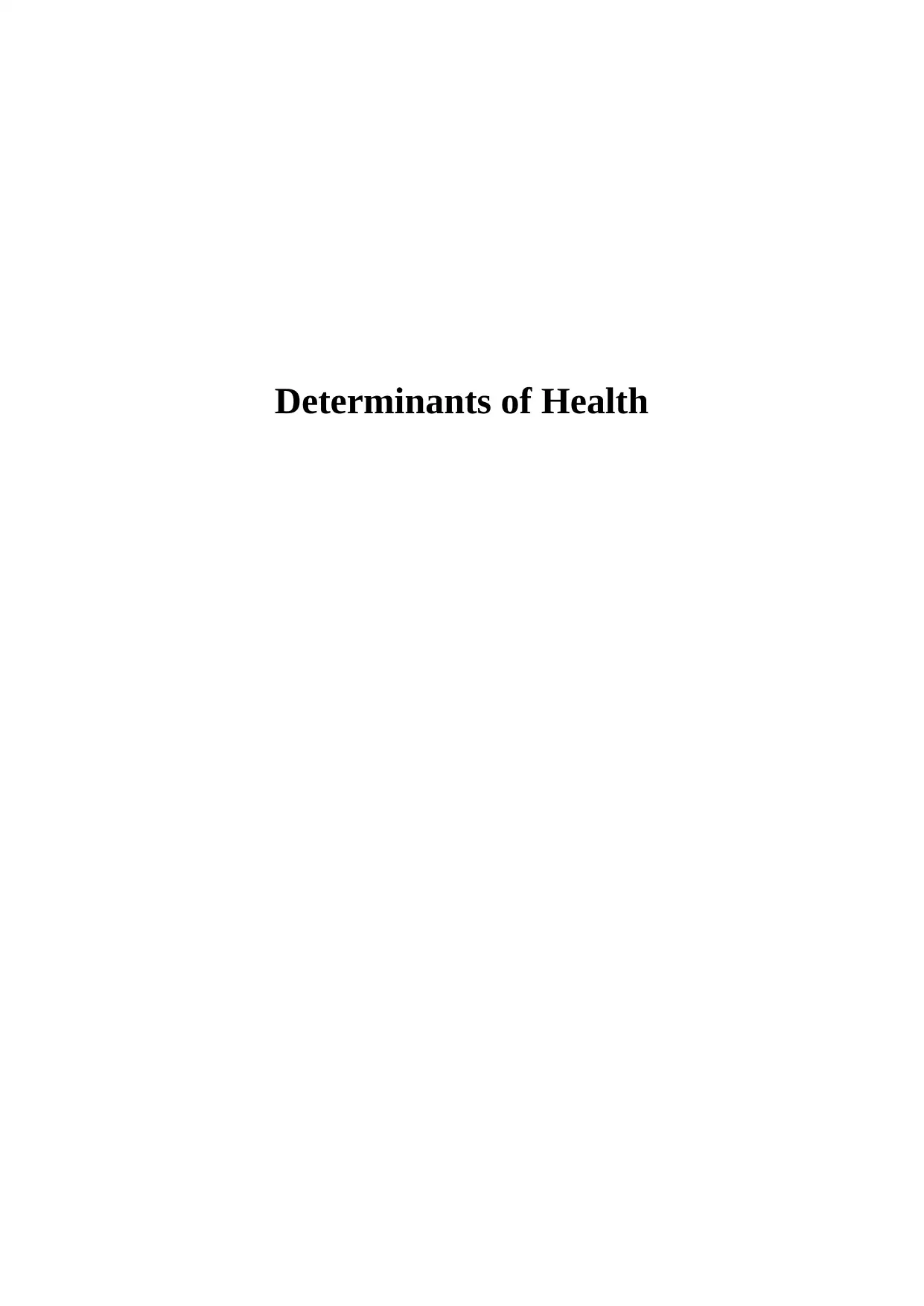
Determinants of Health
Paraphrase This Document
Need a fresh take? Get an instant paraphrase of this document with our AI Paraphraser
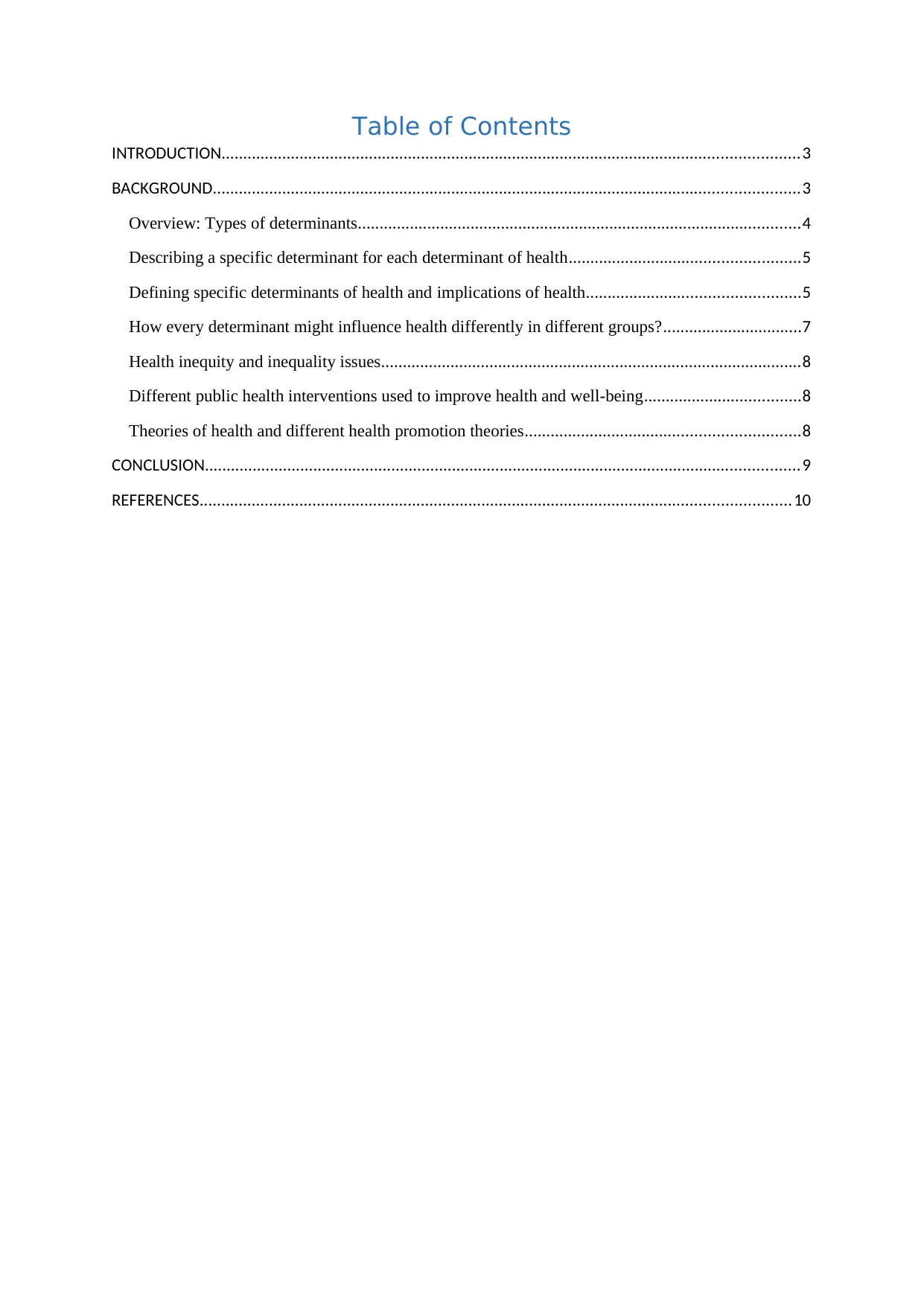
Table of Contents
INTRODUCTION.....................................................................................................................................3
BACKGROUND.......................................................................................................................................3
Overview: Types of determinants......................................................................................................4
Describing a specific determinant for each determinant of health.....................................................5
Defining specific determinants of health and implications of health.................................................5
How every determinant might influence health differently in different groups?................................7
Health inequity and inequality issues.................................................................................................8
Different public health interventions used to improve health and well-being....................................8
Theories of health and different health promotion theories...............................................................8
CONCLUSION.........................................................................................................................................9
REFERENCES........................................................................................................................................10
INTRODUCTION.....................................................................................................................................3
BACKGROUND.......................................................................................................................................3
Overview: Types of determinants......................................................................................................4
Describing a specific determinant for each determinant of health.....................................................5
Defining specific determinants of health and implications of health.................................................5
How every determinant might influence health differently in different groups?................................7
Health inequity and inequality issues.................................................................................................8
Different public health interventions used to improve health and well-being....................................8
Theories of health and different health promotion theories...............................................................8
CONCLUSION.........................................................................................................................................9
REFERENCES........................................................................................................................................10
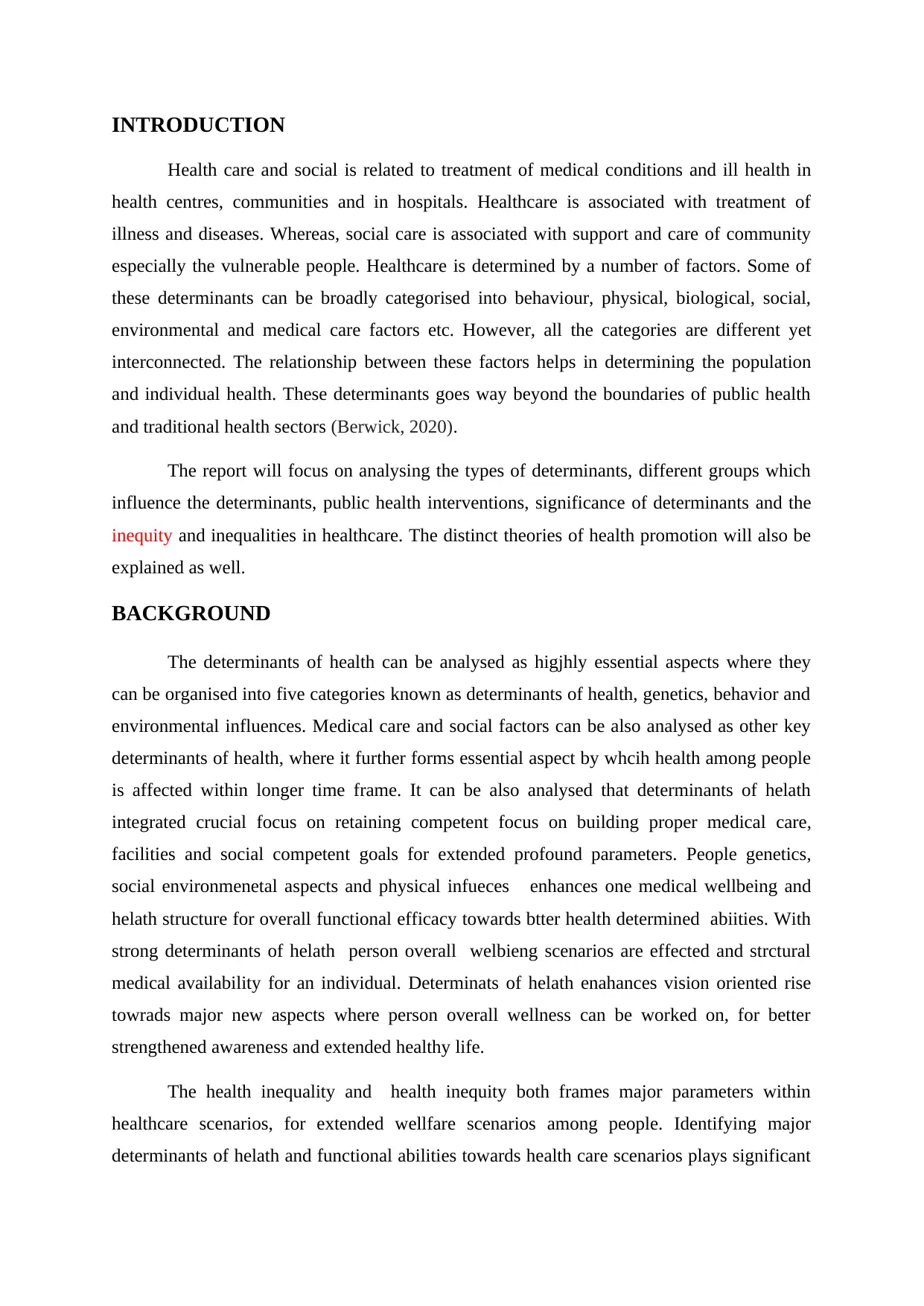
INTRODUCTION
Health care and social is related to treatment of medical conditions and ill health in
health centres, communities and in hospitals. Healthcare is associated with treatment of
illness and diseases. Whereas, social care is associated with support and care of community
especially the vulnerable people. Healthcare is determined by a number of factors. Some of
these determinants can be broadly categorised into behaviour, physical, biological, social,
environmental and medical care factors etc. However, all the categories are different yet
interconnected. The relationship between these factors helps in determining the population
and individual health. These determinants goes way beyond the boundaries of public health
and traditional health sectors (Berwick, 2020).
The report will focus on analysing the types of determinants, different groups which
influence the determinants, public health interventions, significance of determinants and the
inequity and inequalities in healthcare. The distinct theories of health promotion will also be
explained as well.
BACKGROUND
The determinants of health can be analysed as higjhly essential aspects where they
can be organised into five categories known as determinants of health, genetics, behavior and
environmental influences. Medical care and social factors can be also analysed as other key
determinants of health, where it further forms essential aspect by whcih health among people
is affected within longer time frame. It can be also analysed that determinants of helath
integrated crucial focus on retaining competent focus on building proper medical care,
facilities and social competent goals for extended profound parameters. People genetics,
social environmenetal aspects and physical infueces enhances one medical wellbeing and
helath structure for overall functional efficacy towards btter health determined abiities. With
strong determinants of helath person overall welbieng scenarios are effected and strctural
medical availability for an individual. Determinats of helath enahances vision oriented rise
towrads major new aspects where person overall wellness can be worked on, for better
strengthened awareness and extended healthy life.
The health inequality and health inequity both frames major parameters within
healthcare scenarios, for extended wellfare scenarios among people. Identifying major
determinants of helath and functional abilities towards health care scenarios plays significant
Health care and social is related to treatment of medical conditions and ill health in
health centres, communities and in hospitals. Healthcare is associated with treatment of
illness and diseases. Whereas, social care is associated with support and care of community
especially the vulnerable people. Healthcare is determined by a number of factors. Some of
these determinants can be broadly categorised into behaviour, physical, biological, social,
environmental and medical care factors etc. However, all the categories are different yet
interconnected. The relationship between these factors helps in determining the population
and individual health. These determinants goes way beyond the boundaries of public health
and traditional health sectors (Berwick, 2020).
The report will focus on analysing the types of determinants, different groups which
influence the determinants, public health interventions, significance of determinants and the
inequity and inequalities in healthcare. The distinct theories of health promotion will also be
explained as well.
BACKGROUND
The determinants of health can be analysed as higjhly essential aspects where they
can be organised into five categories known as determinants of health, genetics, behavior and
environmental influences. Medical care and social factors can be also analysed as other key
determinants of health, where it further forms essential aspect by whcih health among people
is affected within longer time frame. It can be also analysed that determinants of helath
integrated crucial focus on retaining competent focus on building proper medical care,
facilities and social competent goals for extended profound parameters. People genetics,
social environmenetal aspects and physical infueces enhances one medical wellbeing and
helath structure for overall functional efficacy towards btter health determined abiities. With
strong determinants of helath person overall welbieng scenarios are effected and strctural
medical availability for an individual. Determinats of helath enahances vision oriented rise
towrads major new aspects where person overall wellness can be worked on, for better
strengthened awareness and extended healthy life.
The health inequality and health inequity both frames major parameters within
healthcare scenarios, for extended wellfare scenarios among people. Identifying major
determinants of helath and functional abilities towards health care scenarios plays significant
⊘ This is a preview!⊘
Do you want full access?
Subscribe today to unlock all pages.

Trusted by 1+ million students worldwide
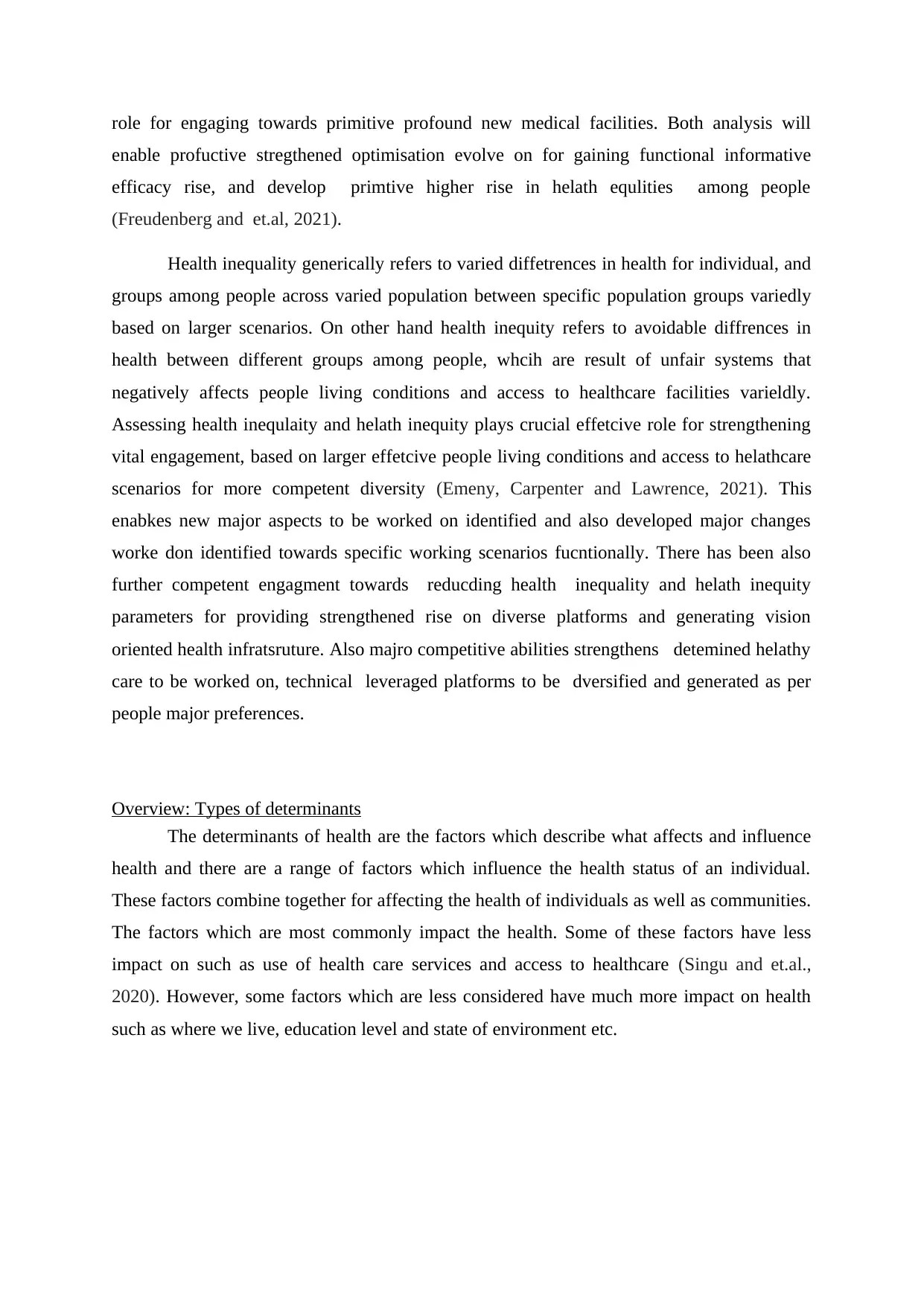
role for engaging towards primitive profound new medical facilities. Both analysis will
enable profuctive stregthened optimisation evolve on for gaining functional informative
efficacy rise, and develop primtive higher rise in helath equlities among people
(Freudenberg and et.al, 2021).
Health inequality generically refers to varied diffetrences in health for individual, and
groups among people across varied population between specific population groups variedly
based on larger scenarios. On other hand health inequity refers to avoidable diffrences in
health between different groups among people, whcih are result of unfair systems that
negatively affects people living conditions and access to healthcare facilities varieldly.
Assessing health inequlaity and helath inequity plays crucial effetcive role for strengthening
vital engagement, based on larger effetcive people living conditions and access to helathcare
scenarios for more competent diversity (Emeny, Carpenter and Lawrence, 2021). This
enabkes new major aspects to be worked on identified and also developed major changes
worke don identified towards specific working scenarios fucntionally. There has been also
further competent engagment towards reducding health inequality and helath inequity
parameters for providing strengthened rise on diverse platforms and generating vision
oriented health infratsruture. Also majro competitive abilities strengthens detemined helathy
care to be worked on, technical leveraged platforms to be dversified and generated as per
people major preferences.
Overview: Types of determinants
The determinants of health are the factors which describe what affects and influence
health and there are a range of factors which influence the health status of an individual.
These factors combine together for affecting the health of individuals as well as communities.
The factors which are most commonly impact the health. Some of these factors have less
impact on such as use of health care services and access to healthcare (Singu and et.al.,
2020). However, some factors which are less considered have much more impact on health
such as where we live, education level and state of environment etc.
enable profuctive stregthened optimisation evolve on for gaining functional informative
efficacy rise, and develop primtive higher rise in helath equlities among people
(Freudenberg and et.al, 2021).
Health inequality generically refers to varied diffetrences in health for individual, and
groups among people across varied population between specific population groups variedly
based on larger scenarios. On other hand health inequity refers to avoidable diffrences in
health between different groups among people, whcih are result of unfair systems that
negatively affects people living conditions and access to healthcare facilities varieldly.
Assessing health inequlaity and helath inequity plays crucial effetcive role for strengthening
vital engagement, based on larger effetcive people living conditions and access to helathcare
scenarios for more competent diversity (Emeny, Carpenter and Lawrence, 2021). This
enabkes new major aspects to be worked on identified and also developed major changes
worke don identified towards specific working scenarios fucntionally. There has been also
further competent engagment towards reducding health inequality and helath inequity
parameters for providing strengthened rise on diverse platforms and generating vision
oriented health infratsruture. Also majro competitive abilities strengthens detemined helathy
care to be worked on, technical leveraged platforms to be dversified and generated as per
people major preferences.
Overview: Types of determinants
The determinants of health are the factors which describe what affects and influence
health and there are a range of factors which influence the health status of an individual.
These factors combine together for affecting the health of individuals as well as communities.
The factors which are most commonly impact the health. Some of these factors have less
impact on such as use of health care services and access to healthcare (Singu and et.al.,
2020). However, some factors which are less considered have much more impact on health
such as where we live, education level and state of environment etc.
Paraphrase This Document
Need a fresh take? Get an instant paraphrase of this document with our AI Paraphraser
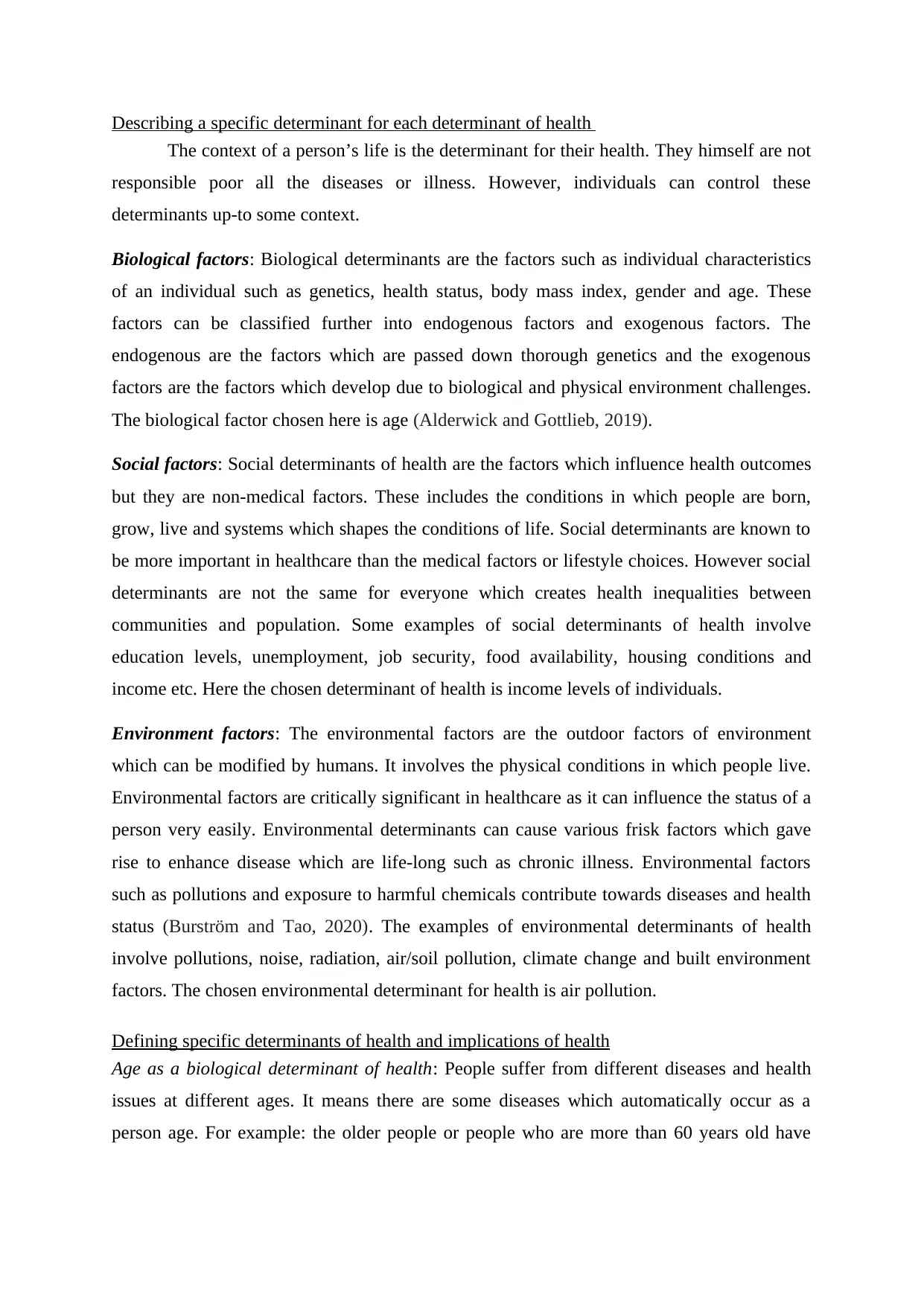
Describing a specific determinant for each determinant of health
The context of a person’s life is the determinant for their health. They himself are not
responsible poor all the diseases or illness. However, individuals can control these
determinants up-to some context.
Biological factors: Biological determinants are the factors such as individual characteristics
of an individual such as genetics, health status, body mass index, gender and age. These
factors can be classified further into endogenous factors and exogenous factors. The
endogenous are the factors which are passed down thorough genetics and the exogenous
factors are the factors which develop due to biological and physical environment challenges.
The biological factor chosen here is age (Alderwick and Gottlieb, 2019).
Social factors: Social determinants of health are the factors which influence health outcomes
but they are non-medical factors. These includes the conditions in which people are born,
grow, live and systems which shapes the conditions of life. Social determinants are known to
be more important in healthcare than the medical factors or lifestyle choices. However social
determinants are not the same for everyone which creates health inequalities between
communities and population. Some examples of social determinants of health involve
education levels, unemployment, job security, food availability, housing conditions and
income etc. Here the chosen determinant of health is income levels of individuals.
Environment factors: The environmental factors are the outdoor factors of environment
which can be modified by humans. It involves the physical conditions in which people live.
Environmental factors are critically significant in healthcare as it can influence the status of a
person very easily. Environmental determinants can cause various frisk factors which gave
rise to enhance disease which are life-long such as chronic illness. Environmental factors
such as pollutions and exposure to harmful chemicals contribute towards diseases and health
status (Burström and Tao, 2020). The examples of environmental determinants of health
involve pollutions, noise, radiation, air/soil pollution, climate change and built environment
factors. The chosen environmental determinant for health is air pollution.
Defining specific determinants of health and implications of health
Age as a biological determinant of health: People suffer from different diseases and health
issues at different ages. It means there are some diseases which automatically occur as a
person age. For example: the older people or people who are more than 60 years old have
The context of a person’s life is the determinant for their health. They himself are not
responsible poor all the diseases or illness. However, individuals can control these
determinants up-to some context.
Biological factors: Biological determinants are the factors such as individual characteristics
of an individual such as genetics, health status, body mass index, gender and age. These
factors can be classified further into endogenous factors and exogenous factors. The
endogenous are the factors which are passed down thorough genetics and the exogenous
factors are the factors which develop due to biological and physical environment challenges.
The biological factor chosen here is age (Alderwick and Gottlieb, 2019).
Social factors: Social determinants of health are the factors which influence health outcomes
but they are non-medical factors. These includes the conditions in which people are born,
grow, live and systems which shapes the conditions of life. Social determinants are known to
be more important in healthcare than the medical factors or lifestyle choices. However social
determinants are not the same for everyone which creates health inequalities between
communities and population. Some examples of social determinants of health involve
education levels, unemployment, job security, food availability, housing conditions and
income etc. Here the chosen determinant of health is income levels of individuals.
Environment factors: The environmental factors are the outdoor factors of environment
which can be modified by humans. It involves the physical conditions in which people live.
Environmental factors are critically significant in healthcare as it can influence the status of a
person very easily. Environmental determinants can cause various frisk factors which gave
rise to enhance disease which are life-long such as chronic illness. Environmental factors
such as pollutions and exposure to harmful chemicals contribute towards diseases and health
status (Burström and Tao, 2020). The examples of environmental determinants of health
involve pollutions, noise, radiation, air/soil pollution, climate change and built environment
factors. The chosen environmental determinant for health is air pollution.
Defining specific determinants of health and implications of health
Age as a biological determinant of health: People suffer from different diseases and health
issues at different ages. It means there are some diseases which automatically occur as a
person age. For example: the older people or people who are more than 60 years old have
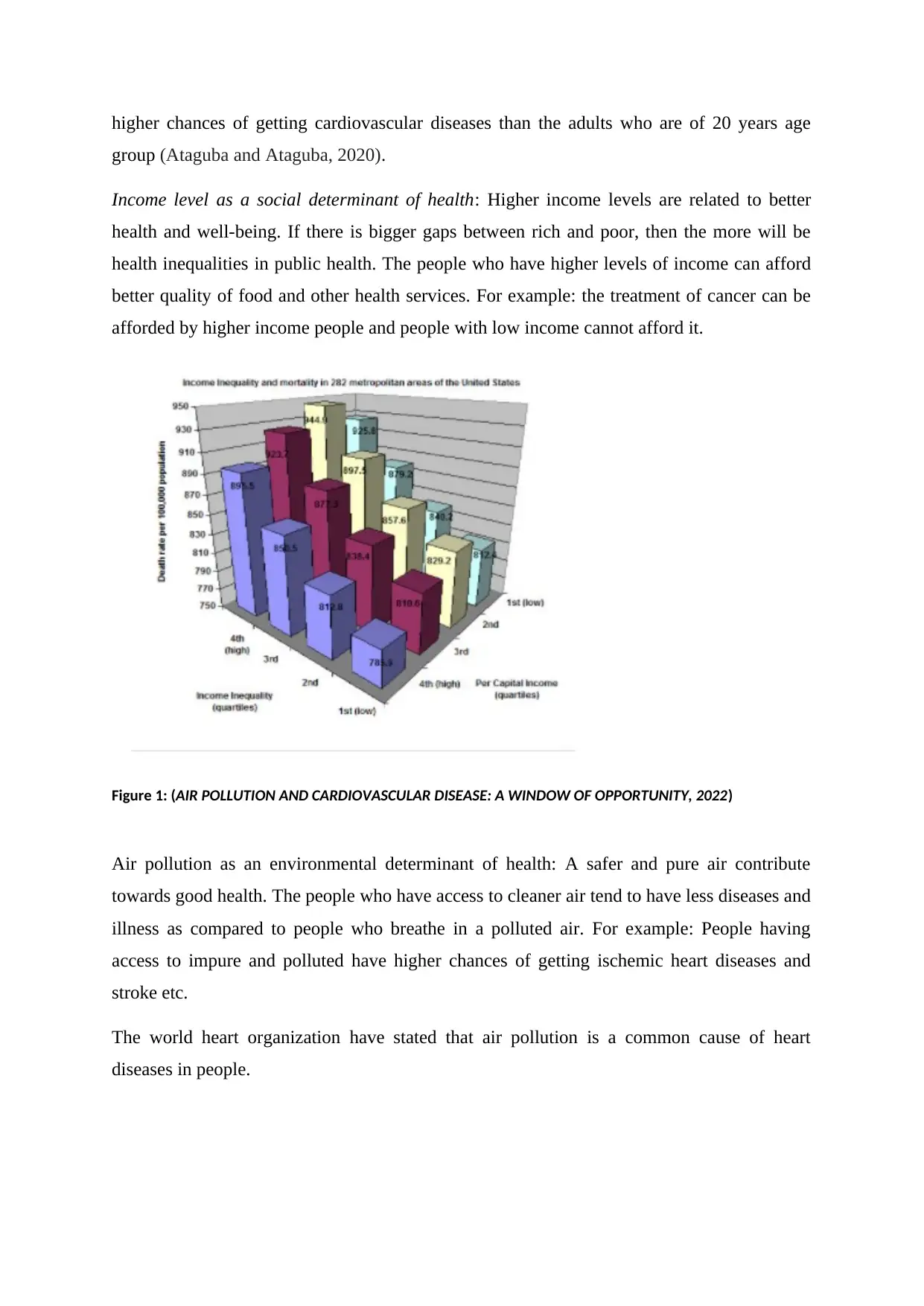
higher chances of getting cardiovascular diseases than the adults who are of 20 years age
group (Ataguba and Ataguba, 2020).
Income level as a social determinant of health: Higher income levels are related to better
health and well-being. If there is bigger gaps between rich and poor, then the more will be
health inequalities in public health. The people who have higher levels of income can afford
better quality of food and other health services. For example: the treatment of cancer can be
afforded by higher income people and people with low income cannot afford it.
Figure 1: (AIR POLLUTION AND CARDIOVASCULAR DISEASE: A WINDOW OF OPPORTUNITY, 2022)
Air pollution as an environmental determinant of health: A safer and pure air contribute
towards good health. The people who have access to cleaner air tend to have less diseases and
illness as compared to people who breathe in a polluted air. For example: People having
access to impure and polluted have higher chances of getting ischemic heart diseases and
stroke etc.
The world heart organization have stated that air pollution is a common cause of heart
diseases in people.
group (Ataguba and Ataguba, 2020).
Income level as a social determinant of health: Higher income levels are related to better
health and well-being. If there is bigger gaps between rich and poor, then the more will be
health inequalities in public health. The people who have higher levels of income can afford
better quality of food and other health services. For example: the treatment of cancer can be
afforded by higher income people and people with low income cannot afford it.
Figure 1: (AIR POLLUTION AND CARDIOVASCULAR DISEASE: A WINDOW OF OPPORTUNITY, 2022)
Air pollution as an environmental determinant of health: A safer and pure air contribute
towards good health. The people who have access to cleaner air tend to have less diseases and
illness as compared to people who breathe in a polluted air. For example: People having
access to impure and polluted have higher chances of getting ischemic heart diseases and
stroke etc.
The world heart organization have stated that air pollution is a common cause of heart
diseases in people.
⊘ This is a preview!⊘
Do you want full access?
Subscribe today to unlock all pages.

Trusted by 1+ million students worldwide
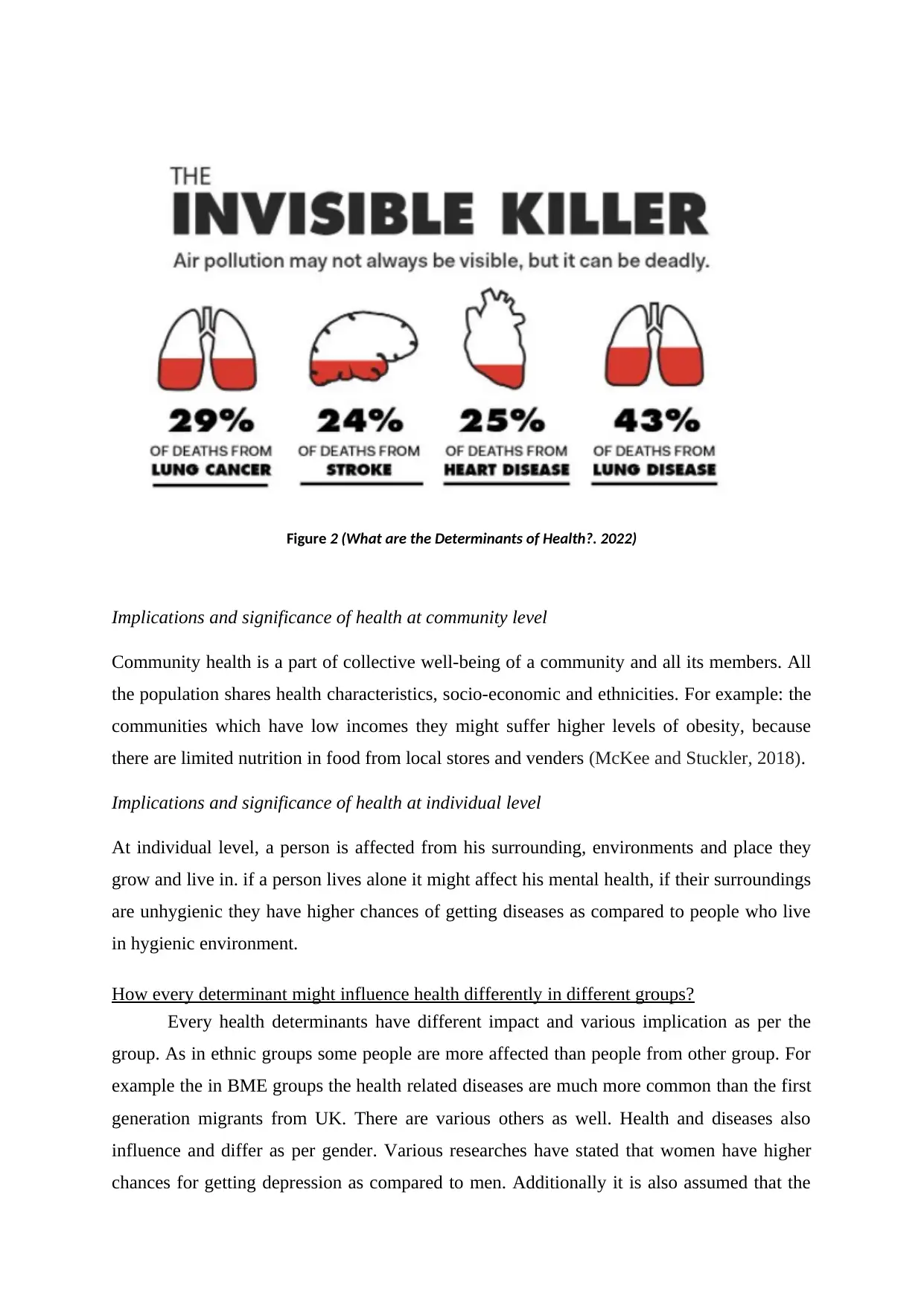
Figure 2 (What are the Determinants of Health?. 2022)
Implications and significance of health at community level
Community health is a part of collective well-being of a community and all its members. All
the population shares health characteristics, socio-economic and ethnicities. For example: the
communities which have low incomes they might suffer higher levels of obesity, because
there are limited nutrition in food from local stores and venders (McKee and Stuckler, 2018).
Implications and significance of health at individual level
At individual level, a person is affected from his surrounding, environments and place they
grow and live in. if a person lives alone it might affect his mental health, if their surroundings
are unhygienic they have higher chances of getting diseases as compared to people who live
in hygienic environment.
How every determinant might influence health differently in different groups?
Every health determinants have different impact and various implication as per the
group. As in ethnic groups some people are more affected than people from other group. For
example the in BME groups the health related diseases are much more common than the first
generation migrants from UK. There are various others as well. Health and diseases also
influence and differ as per gender. Various researches have stated that women have higher
chances for getting depression as compared to men. Additionally it is also assumed that the
Implications and significance of health at community level
Community health is a part of collective well-being of a community and all its members. All
the population shares health characteristics, socio-economic and ethnicities. For example: the
communities which have low incomes they might suffer higher levels of obesity, because
there are limited nutrition in food from local stores and venders (McKee and Stuckler, 2018).
Implications and significance of health at individual level
At individual level, a person is affected from his surrounding, environments and place they
grow and live in. if a person lives alone it might affect his mental health, if their surroundings
are unhygienic they have higher chances of getting diseases as compared to people who live
in hygienic environment.
How every determinant might influence health differently in different groups?
Every health determinants have different impact and various implication as per the
group. As in ethnic groups some people are more affected than people from other group. For
example the in BME groups the health related diseases are much more common than the first
generation migrants from UK. There are various others as well. Health and diseases also
influence and differ as per gender. Various researches have stated that women have higher
chances for getting depression as compared to men. Additionally it is also assumed that the
Paraphrase This Document
Need a fresh take? Get an instant paraphrase of this document with our AI Paraphraser
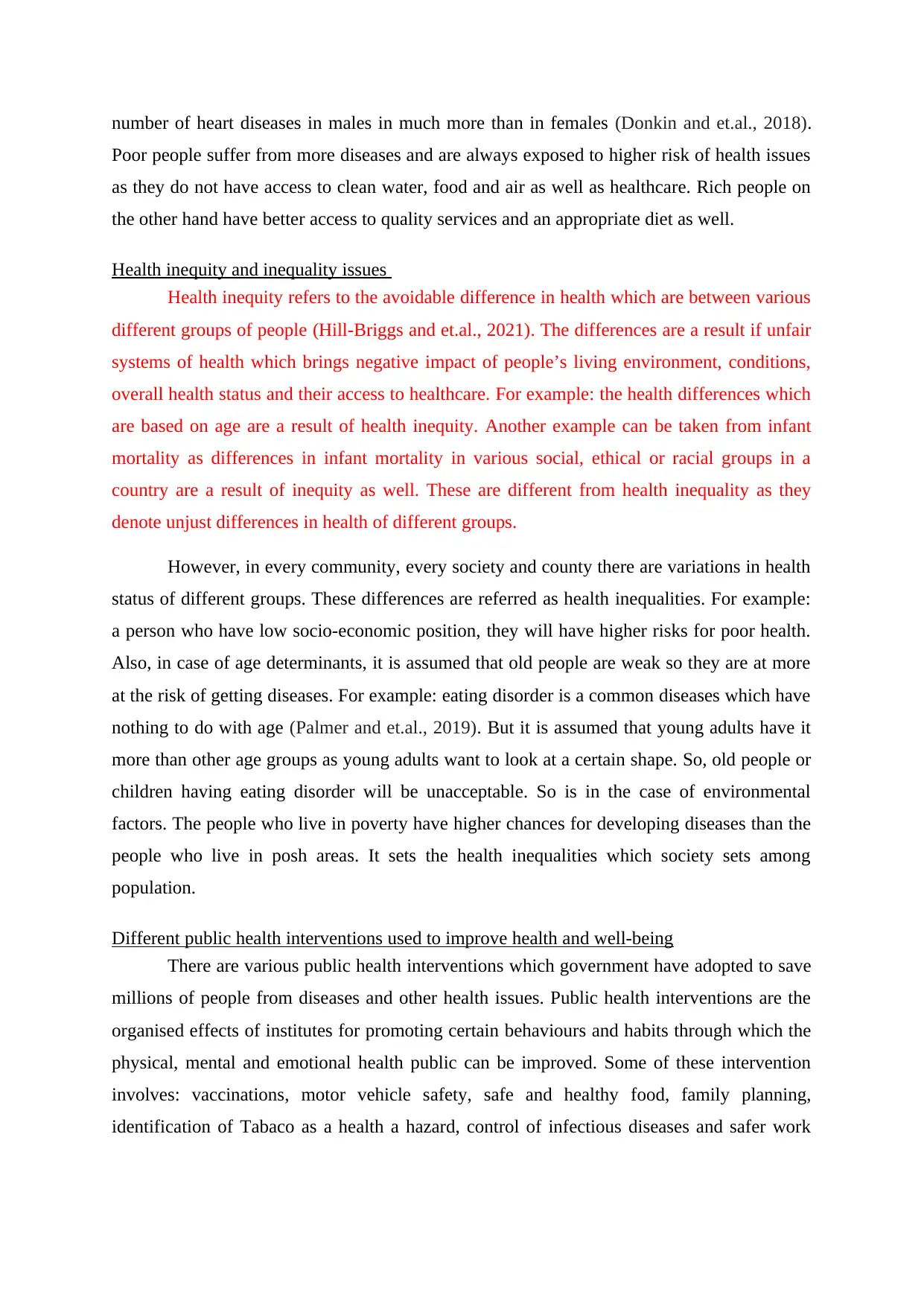
number of heart diseases in males in much more than in females (Donkin and et.al., 2018).
Poor people suffer from more diseases and are always exposed to higher risk of health issues
as they do not have access to clean water, food and air as well as healthcare. Rich people on
the other hand have better access to quality services and an appropriate diet as well.
Health inequity and inequality issues
Health inequity refers to the avoidable difference in health which are between various
different groups of people (Hill-Briggs and et.al., 2021). The differences are a result if unfair
systems of health which brings negative impact of people’s living environment, conditions,
overall health status and their access to healthcare. For example: the health differences which
are based on age are a result of health inequity. Another example can be taken from infant
mortality as differences in infant mortality in various social, ethical or racial groups in a
country are a result of inequity as well. These are different from health inequality as they
denote unjust differences in health of different groups.
However, in every community, every society and county there are variations in health
status of different groups. These differences are referred as health inequalities. For example:
a person who have low socio-economic position, they will have higher risks for poor health.
Also, in case of age determinants, it is assumed that old people are weak so they are at more
at the risk of getting diseases. For example: eating disorder is a common diseases which have
nothing to do with age (Palmer and et.al., 2019). But it is assumed that young adults have it
more than other age groups as young adults want to look at a certain shape. So, old people or
children having eating disorder will be unacceptable. So is in the case of environmental
factors. The people who live in poverty have higher chances for developing diseases than the
people who live in posh areas. It sets the health inequalities which society sets among
population.
Different public health interventions used to improve health and well-being
There are various public health interventions which government have adopted to save
millions of people from diseases and other health issues. Public health interventions are the
organised effects of institutes for promoting certain behaviours and habits through which the
physical, mental and emotional health public can be improved. Some of these intervention
involves: vaccinations, motor vehicle safety, safe and healthy food, family planning,
identification of Tabaco as a health a hazard, control of infectious diseases and safer work
Poor people suffer from more diseases and are always exposed to higher risk of health issues
as they do not have access to clean water, food and air as well as healthcare. Rich people on
the other hand have better access to quality services and an appropriate diet as well.
Health inequity and inequality issues
Health inequity refers to the avoidable difference in health which are between various
different groups of people (Hill-Briggs and et.al., 2021). The differences are a result if unfair
systems of health which brings negative impact of people’s living environment, conditions,
overall health status and their access to healthcare. For example: the health differences which
are based on age are a result of health inequity. Another example can be taken from infant
mortality as differences in infant mortality in various social, ethical or racial groups in a
country are a result of inequity as well. These are different from health inequality as they
denote unjust differences in health of different groups.
However, in every community, every society and county there are variations in health
status of different groups. These differences are referred as health inequalities. For example:
a person who have low socio-economic position, they will have higher risks for poor health.
Also, in case of age determinants, it is assumed that old people are weak so they are at more
at the risk of getting diseases. For example: eating disorder is a common diseases which have
nothing to do with age (Palmer and et.al., 2019). But it is assumed that young adults have it
more than other age groups as young adults want to look at a certain shape. So, old people or
children having eating disorder will be unacceptable. So is in the case of environmental
factors. The people who live in poverty have higher chances for developing diseases than the
people who live in posh areas. It sets the health inequalities which society sets among
population.
Different public health interventions used to improve health and well-being
There are various public health interventions which government have adopted to save
millions of people from diseases and other health issues. Public health interventions are the
organised effects of institutes for promoting certain behaviours and habits through which the
physical, mental and emotional health public can be improved. Some of these intervention
involves: vaccinations, motor vehicle safety, safe and healthy food, family planning,
identification of Tabaco as a health a hazard, control of infectious diseases and safer work
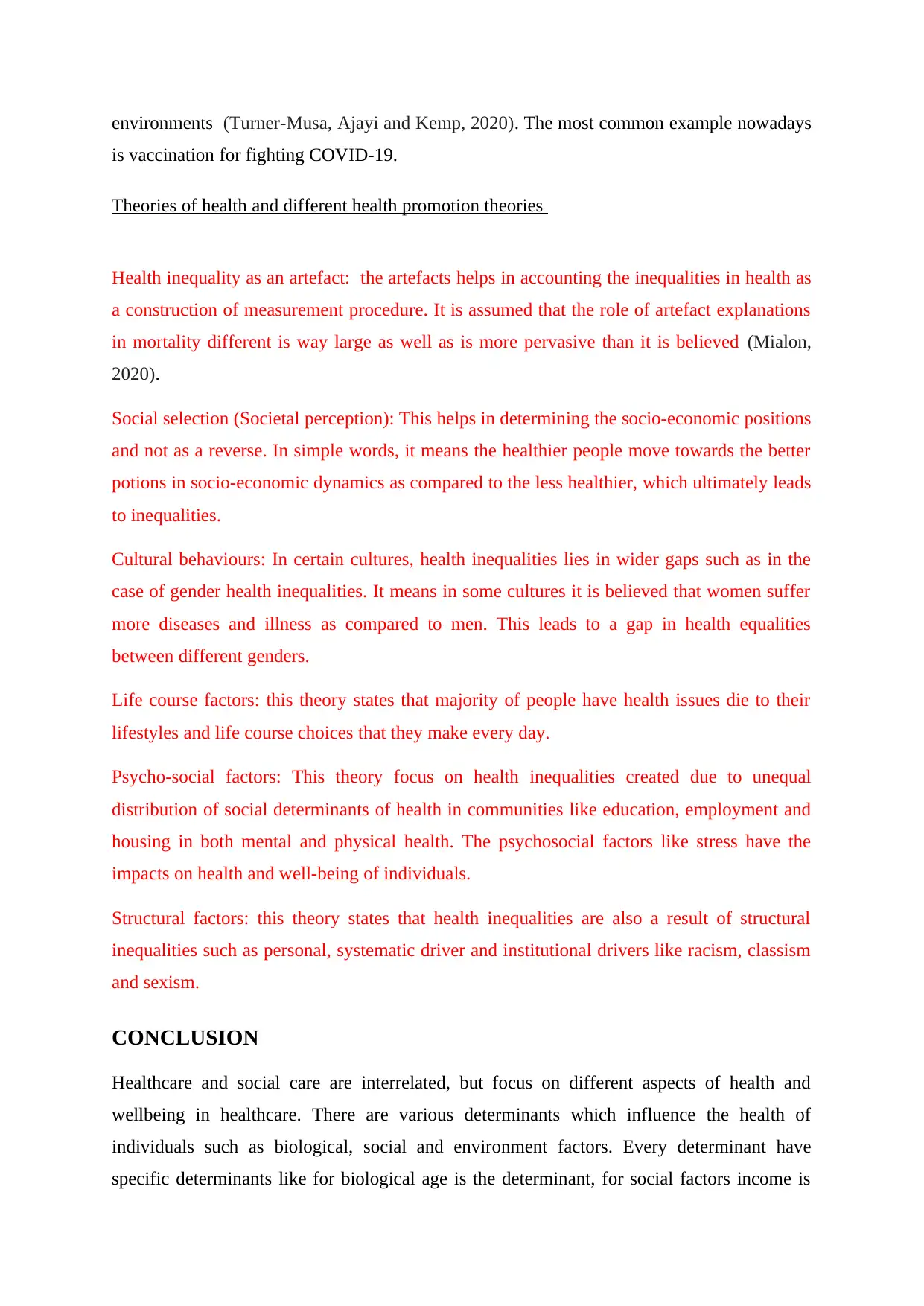
environments (Turner-Musa, Ajayi and Kemp, 2020). The most common example nowadays
is vaccination for fighting COVID-19.
Theories of health and different health promotion theories
Health inequality as an artefact: the artefacts helps in accounting the inequalities in health as
a construction of measurement procedure. It is assumed that the role of artefact explanations
in mortality different is way large as well as is more pervasive than it is believed (Mialon,
2020).
Social selection (Societal perception): This helps in determining the socio-economic positions
and not as a reverse. In simple words, it means the healthier people move towards the better
potions in socio-economic dynamics as compared to the less healthier, which ultimately leads
to inequalities.
Cultural behaviours: In certain cultures, health inequalities lies in wider gaps such as in the
case of gender health inequalities. It means in some cultures it is believed that women suffer
more diseases and illness as compared to men. This leads to a gap in health equalities
between different genders.
Life course factors: this theory states that majority of people have health issues die to their
lifestyles and life course choices that they make every day.
Psycho-social factors: This theory focus on health inequalities created due to unequal
distribution of social determinants of health in communities like education, employment and
housing in both mental and physical health. The psychosocial factors like stress have the
impacts on health and well-being of individuals.
Structural factors: this theory states that health inequalities are also a result of structural
inequalities such as personal, systematic driver and institutional drivers like racism, classism
and sexism.
CONCLUSION
Healthcare and social care are interrelated, but focus on different aspects of health and
wellbeing in healthcare. There are various determinants which influence the health of
individuals such as biological, social and environment factors. Every determinant have
specific determinants like for biological age is the determinant, for social factors income is
is vaccination for fighting COVID-19.
Theories of health and different health promotion theories
Health inequality as an artefact: the artefacts helps in accounting the inequalities in health as
a construction of measurement procedure. It is assumed that the role of artefact explanations
in mortality different is way large as well as is more pervasive than it is believed (Mialon,
2020).
Social selection (Societal perception): This helps in determining the socio-economic positions
and not as a reverse. In simple words, it means the healthier people move towards the better
potions in socio-economic dynamics as compared to the less healthier, which ultimately leads
to inequalities.
Cultural behaviours: In certain cultures, health inequalities lies in wider gaps such as in the
case of gender health inequalities. It means in some cultures it is believed that women suffer
more diseases and illness as compared to men. This leads to a gap in health equalities
between different genders.
Life course factors: this theory states that majority of people have health issues die to their
lifestyles and life course choices that they make every day.
Psycho-social factors: This theory focus on health inequalities created due to unequal
distribution of social determinants of health in communities like education, employment and
housing in both mental and physical health. The psychosocial factors like stress have the
impacts on health and well-being of individuals.
Structural factors: this theory states that health inequalities are also a result of structural
inequalities such as personal, systematic driver and institutional drivers like racism, classism
and sexism.
CONCLUSION
Healthcare and social care are interrelated, but focus on different aspects of health and
wellbeing in healthcare. There are various determinants which influence the health of
individuals such as biological, social and environment factors. Every determinant have
specific determinants like for biological age is the determinant, for social factors income is
⊘ This is a preview!⊘
Do you want full access?
Subscribe today to unlock all pages.

Trusted by 1+ million students worldwide
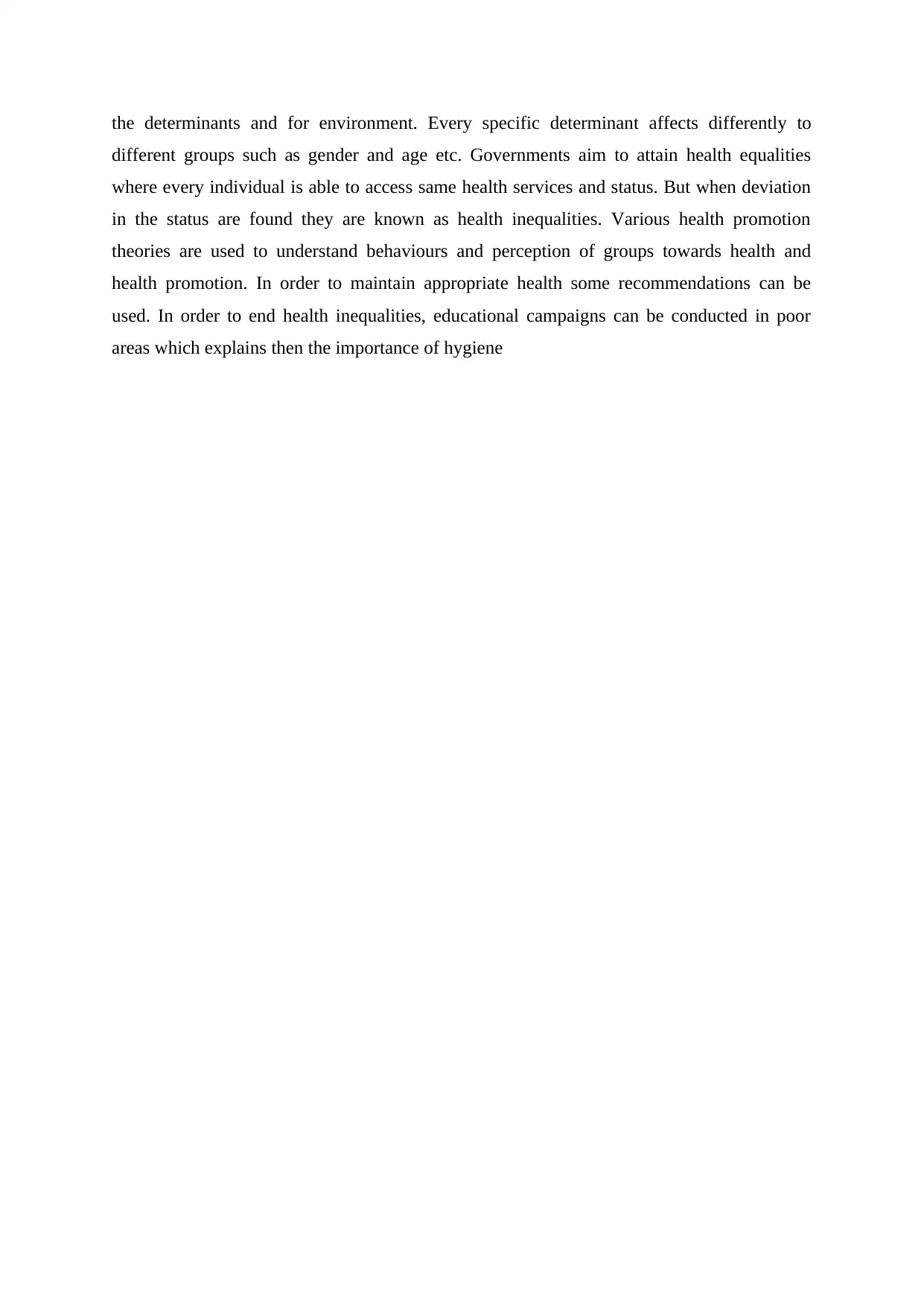
the determinants and for environment. Every specific determinant affects differently to
different groups such as gender and age etc. Governments aim to attain health equalities
where every individual is able to access same health services and status. But when deviation
in the status are found they are known as health inequalities. Various health promotion
theories are used to understand behaviours and perception of groups towards health and
health promotion. In order to maintain appropriate health some recommendations can be
used. In order to end health inequalities, educational campaigns can be conducted in poor
areas which explains then the importance of hygiene
different groups such as gender and age etc. Governments aim to attain health equalities
where every individual is able to access same health services and status. But when deviation
in the status are found they are known as health inequalities. Various health promotion
theories are used to understand behaviours and perception of groups towards health and
health promotion. In order to maintain appropriate health some recommendations can be
used. In order to end health inequalities, educational campaigns can be conducted in poor
areas which explains then the importance of hygiene
Paraphrase This Document
Need a fresh take? Get an instant paraphrase of this document with our AI Paraphraser
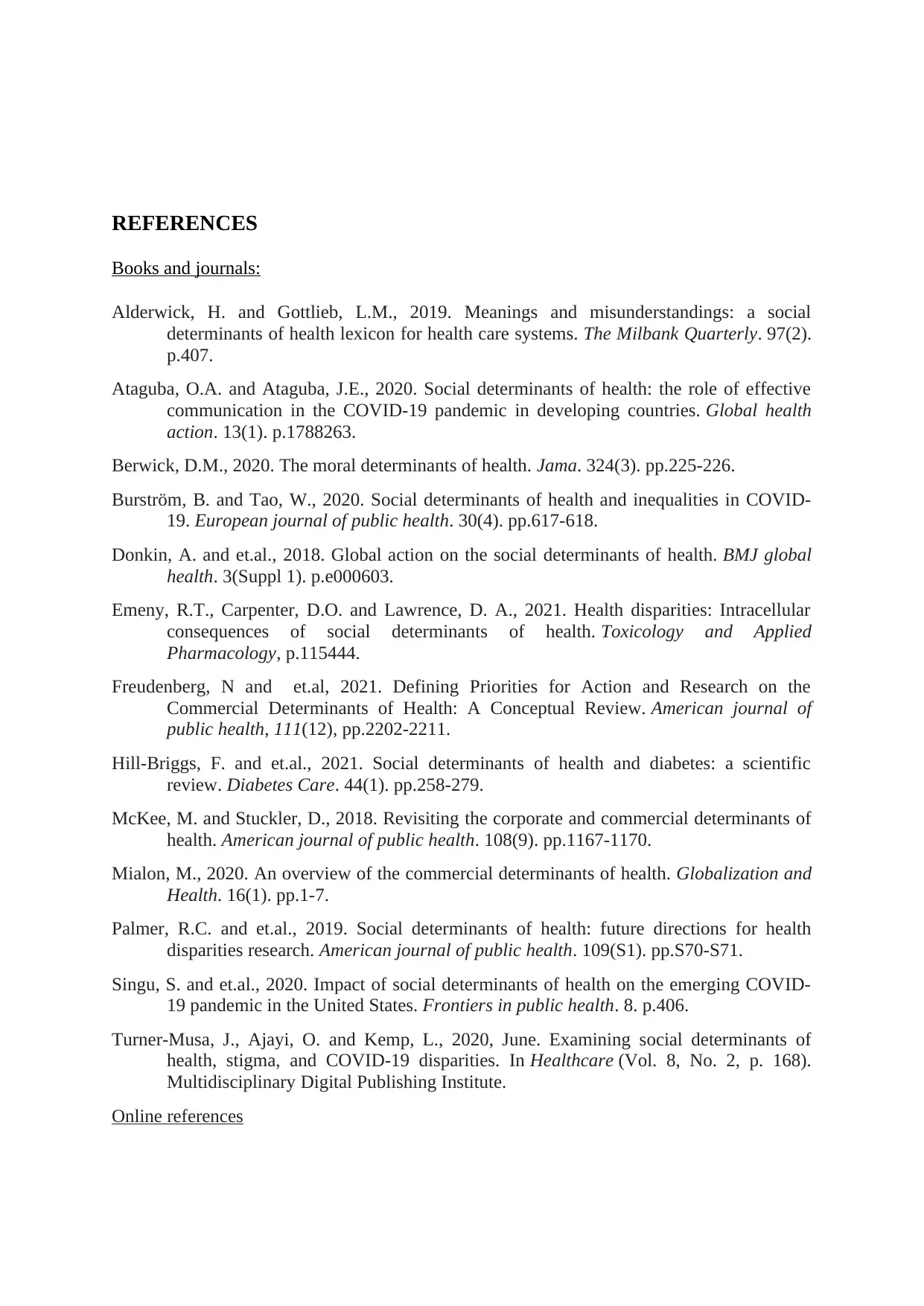
REFERENCES
Books and journals:
Alderwick, H. and Gottlieb, L.M., 2019. Meanings and misunderstandings: a social
determinants of health lexicon for health care systems. The Milbank Quarterly. 97(2).
p.407.
Ataguba, O.A. and Ataguba, J.E., 2020. Social determinants of health: the role of effective
communication in the COVID-19 pandemic in developing countries. Global health
action. 13(1). p.1788263.
Berwick, D.M., 2020. The moral determinants of health. Jama. 324(3). pp.225-226.
Burström, B. and Tao, W., 2020. Social determinants of health and inequalities in COVID-
19. European journal of public health. 30(4). pp.617-618.
Donkin, A. and et.al., 2018. Global action on the social determinants of health. BMJ global
health. 3(Suppl 1). p.e000603.
Emeny, R.T., Carpenter, D.O. and Lawrence, D. A., 2021. Health disparities: Intracellular
consequences of social determinants of health. Toxicology and Applied
Pharmacology, p.115444.
Freudenberg, N and et.al, 2021. Defining Priorities for Action and Research on the
Commercial Determinants of Health: A Conceptual Review. American journal of
public health, 111(12), pp.2202-2211.
Hill-Briggs, F. and et.al., 2021. Social determinants of health and diabetes: a scientific
review. Diabetes Care. 44(1). pp.258-279.
McKee, M. and Stuckler, D., 2018. Revisiting the corporate and commercial determinants of
health. American journal of public health. 108(9). pp.1167-1170.
Mialon, M., 2020. An overview of the commercial determinants of health. Globalization and
Health. 16(1). pp.1-7.
Palmer, R.C. and et.al., 2019. Social determinants of health: future directions for health
disparities research. American journal of public health. 109(S1). pp.S70-S71.
Singu, S. and et.al., 2020. Impact of social determinants of health on the emerging COVID-
19 pandemic in the United States. Frontiers in public health. 8. p.406.
Turner-Musa, J., Ajayi, O. and Kemp, L., 2020, June. Examining social determinants of
health, stigma, and COVID-19 disparities. In Healthcare (Vol. 8, No. 2, p. 168).
Multidisciplinary Digital Publishing Institute.
Online references
Books and journals:
Alderwick, H. and Gottlieb, L.M., 2019. Meanings and misunderstandings: a social
determinants of health lexicon for health care systems. The Milbank Quarterly. 97(2).
p.407.
Ataguba, O.A. and Ataguba, J.E., 2020. Social determinants of health: the role of effective
communication in the COVID-19 pandemic in developing countries. Global health
action. 13(1). p.1788263.
Berwick, D.M., 2020. The moral determinants of health. Jama. 324(3). pp.225-226.
Burström, B. and Tao, W., 2020. Social determinants of health and inequalities in COVID-
19. European journal of public health. 30(4). pp.617-618.
Donkin, A. and et.al., 2018. Global action on the social determinants of health. BMJ global
health. 3(Suppl 1). p.e000603.
Emeny, R.T., Carpenter, D.O. and Lawrence, D. A., 2021. Health disparities: Intracellular
consequences of social determinants of health. Toxicology and Applied
Pharmacology, p.115444.
Freudenberg, N and et.al, 2021. Defining Priorities for Action and Research on the
Commercial Determinants of Health: A Conceptual Review. American journal of
public health, 111(12), pp.2202-2211.
Hill-Briggs, F. and et.al., 2021. Social determinants of health and diabetes: a scientific
review. Diabetes Care. 44(1). pp.258-279.
McKee, M. and Stuckler, D., 2018. Revisiting the corporate and commercial determinants of
health. American journal of public health. 108(9). pp.1167-1170.
Mialon, M., 2020. An overview of the commercial determinants of health. Globalization and
Health. 16(1). pp.1-7.
Palmer, R.C. and et.al., 2019. Social determinants of health: future directions for health
disparities research. American journal of public health. 109(S1). pp.S70-S71.
Singu, S. and et.al., 2020. Impact of social determinants of health on the emerging COVID-
19 pandemic in the United States. Frontiers in public health. 8. p.406.
Turner-Musa, J., Ajayi, O. and Kemp, L., 2020, June. Examining social determinants of
health, stigma, and COVID-19 disparities. In Healthcare (Vol. 8, No. 2, p. 168).
Multidisciplinary Digital Publishing Institute.
Online references
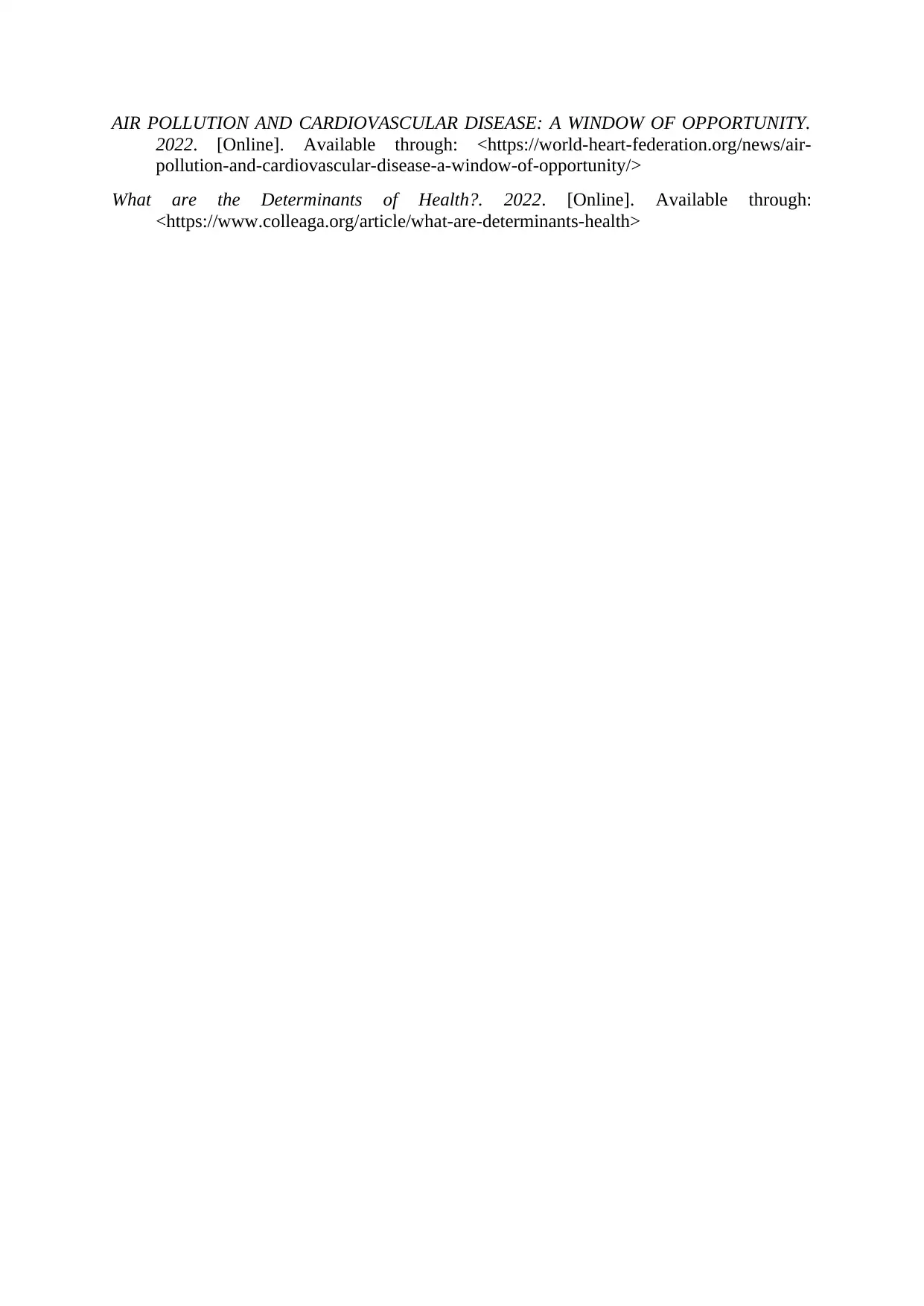
AIR POLLUTION AND CARDIOVASCULAR DISEASE: A WINDOW OF OPPORTUNITY.
2022. [Online]. Available through: <https://world-heart-federation.org/news/air-
pollution-and-cardiovascular-disease-a-window-of-opportunity/>
What are the Determinants of Health?. 2022. [Online]. Available through:
<https://www.colleaga.org/article/what-are-determinants-health>
2022. [Online]. Available through: <https://world-heart-federation.org/news/air-
pollution-and-cardiovascular-disease-a-window-of-opportunity/>
What are the Determinants of Health?. 2022. [Online]. Available through:
<https://www.colleaga.org/article/what-are-determinants-health>
⊘ This is a preview!⊘
Do you want full access?
Subscribe today to unlock all pages.

Trusted by 1+ million students worldwide
1 out of 12
Related Documents
Your All-in-One AI-Powered Toolkit for Academic Success.
+13062052269
info@desklib.com
Available 24*7 on WhatsApp / Email
![[object Object]](/_next/static/media/star-bottom.7253800d.svg)
Unlock your academic potential
Copyright © 2020–2025 A2Z Services. All Rights Reserved. Developed and managed by ZUCOL.



